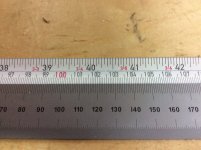I am looking for an accurate metric tape measure. From the attached photo you may be able to see the defect at 353-354mm mark on this Festool tape measure. This tape weaves in and out of accuracy along its length due to these defects. This is actually one of the least troublesome defects on this tape measure. Another example is at 1024mm also in an attached photo. I contacted BMI, the manufacturer of this tape measure, and the gentleman I talked to said there would be no significant quality improvements in any of their branded tape measures if I bought one from them. (He must like his job! Or not. Good grief.) Why be in that business if this is the best they can produce.
So does anyone have a suggestion for a high quality, accurate metric tape measure? At this point I don’t think price is a factor.
Before anyone suggests Fastcap; I have several of their imperial tapes and I like them but they were handpicked from dozens of the units in stock in order to find those that matched and agreed with my shop rulers. The local dealer does not stock enough metric units for this and believe me I tried.
So does anyone have a suggestion for a high quality, accurate metric tape measure? At this point I don’t think price is a factor.
Before anyone suggests Fastcap; I have several of their imperial tapes and I like them but they were handpicked from dozens of the units in stock in order to find those that matched and agreed with my shop rulers. The local dealer does not stock enough metric units for this and believe me I tried.


